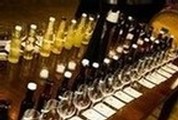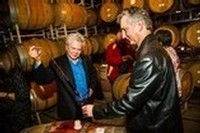Demystifying Wine Aromas ... One Sniff at a Time



Did you know that smell – not taste – is the human sense that defines the overall flavor of wine? The unfortunate thing is that so many people are unsure of themselves when it comes to identifying aromas in wine and developing an understanding of what they enjoy. In fact, they’re downright uncomfortable with the whole experience. That’s one of the reasons I created the Middle Ridge Signature Aroma Table.
The Signature Aroma Table is an interactive, smell-able display of over 40 aroma “reference standards” that are typically used to train wine competition judges and wine writers. The inspiration for it came from a couple courses Melody and I took at UC-Davis – “Introduction to Sensory Evaluation of Wine” and “Descriptive Analysis of Red and White Table Wine.” They are fantastic two-day seminars that I strongly recommend to everyone. In the second course, we were introduced to over 200 aroma standards that mimic what you smell in wine. It was so much fun that I wanted to share the experience with our club members and friends.
Making the aroma standards is a lot of work, though, so I make just a few dozen for the interactive display at our Annual Barrel Tasting. I start with a cheap wine that has little aroma of its own – but it’s important for its alcohol content. I pour the wine into small bottles and then add a single ingredient to each bottle based on the “recipes” developed at UC-Davis. The alcohol in the base wine volatilizes – turns into vapor – the ingredients that are added to it. So, for instance, I’ll add something like juice from a fresh grapefruit to a bottle of white wine, or pureed black cherries to a bottle with red wine. As the ingredient sits in the wine for a couple days, the aromas are extracted and really start to pop. Once the aromas are fully extracted, I strain any solids out of the sample and it’s ready to go!
Although the aroma standards are made from fruit and other ingredients, the aromas naturally occurring in wine are the result of the entire winemaking process. It starts in the vineyards with the soil and climate. For example, the smell of olives is very common in Temecula Valley Cabernet Sauvignon – it’s just something about the area. And then there’s the fermentation process. All kinds of things can happen there. For starters, there are hundreds of strains of yeast that can be used, and each brings out a different aroma from the grapes. The barrel in which a wine is aged affects the aromas, too. Winemakers love to play around with all these things.
If you like the idea of learning about wine aromas and live in Southern California, be sure to join us for our Annual Barrel Tasting event. The Middle Ridge Signature Aroma Table is one of the highlights of the evening, and it’s a lot of fun! You start by getting a glass of wine and then head over to the Aroma Table. I recommend smelling a few of the aroma standards before sniffing your glass of Middle Ridge. Go back and forth, sniffing the aroma standards and comparing them to your own glass of wine. And before you know it, you’ll have an “Aha!” moment and be able to identify some of the aromas in the wine you’re drinking.


Anyone can develop a good “wine nose.” The trick is to smell things whenever possible – smell the produce at the grocery store, sniff the herbs while you’re cooking, smell the flowers in the garden. It’s important to exercise the nose as much as possible. Your brain will store all these impressions even though you’re not consciously aware of it. Just keep working at it, and one day you’ll surprise yourself – and your friends – and start calling out wine aromas!
* * * * *
What can you expect to smell in wine? Check out the Wine Aroma Wheel created by Wine Folly.
Original Source: Wine Aroma Wheel by Wine Folly
Comments
Blog
Recent Posts
-
October 21, 2016
-
October 1, 2016
-
October 22, 2015
-
August 13, 2015(2 Comments)
-
June 30, 2015
-
June 29, 2015(2 Comments)
-
May 19, 2015
-
May 18, 2015
-
November 3, 2014
-
November 1, 2014
Blog Categories
- Events (3)
- Food & Friends (4)
- Idyllwild (1)
- Just For Fun (1)
- Special Offers (1)
- Wine (9)
- Winemaking (1)

